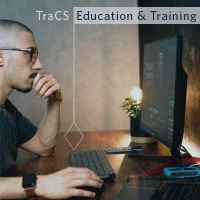Schworer, an assistant professor of rheumatology, allergy, and immunology and the UNC School of Medicine, wants to know how lung tissue becomes asthmatic, in the hope of preventing the disease from developing. Breathing trouble can quickly lead to coughing, wheezing, and chest tightness.
Mehul Patel is saving time for rural stroke patients
Getting stroke patients the care they need quickly and efficiently can be complicated in rural areas far from major hospitals.
Mehul D. Patel, PhD
Mehul Patel, an emergency medicine researcher at the UNC School of Medicine, says that when it comes to strokes, "time is brain."
Patel didn't come up with that phrase—any clinician or researcher who studies stroke will tell you that time is the most important factor. During a stroke, blood flow to the brain is interrupted, causing symptoms like slurred speech, weakness, or dizziness. Without quick medical intervention, brain cells can start to die, potentially leading to chronic disabilities.
But in many rural areas, the nearest hospital may be pretty far away. What's more, if a person is having an especially serious or complicated stroke, they may need specialty care, which is usually only available in hospitals in more urban areas. Sometimes, delays in this care can lead to long-term medical issues. In the worst cases, it can cause a patient to die.
Patel's stroke research focuses on understanding the crucial early moments of stroke care, especially in rural areas that often have fewer healthcare resources. A couple of years ago, he received a KL2 (now K12) award from the North Carolina Translational and Clinical Sciences (NC TraCS) Institute that dived into some of the complications of providing stroke care. Patel is now building on that research, trying to ensure that everyone, no matter what part of the country they live in, can get life-saving stroke care.
...you have these large regions of the state, and the country, that don't have immediate access to the best [stroke] treatment options.
"Stroke is a time-sensitive condition," Patel says. "But you have these large regions of the state, and the country, that don't have immediate access to the best treatment options."
Usually, emergency medical services (EMS) clinicians are the first healthcare professionals to see someone having a stroke. EMS clinicians are trained to identify a stroke, gather information from the patient or others on their symptoms, and support the patient's vitals. But stroke treatment doesn't happen in an ambulance, Patel says.
In large part, that's because there are two different types of strokes, which require different therapeutic strategies. During an ischemic stroke, the most common form of stroke, a clot or blockage prevents blood from reaching the brain and needs to be broken up, often with clot-busting drugs. But during a hemorrhagic stroke, the other type of stroke, a blood vessel in the brain ruptures, spewing blood into the brain. To treat a hemorrhagic stroke, clinicians often need to encourage blood clotting to stop the bleeding. Without advanced diagnostic tools like CT imaging, we can't know whether a person's stroke is ischemic or hemorrhagic, so there's little EMS clinicians can do with the relatively rudimentary medical tools in an ambulance.
Mehul Patel, an emergency medicine researcher at the UNC School of Medicine in an Orange County, NC ambulance as a graduate student in 2012
Once a person gets to a hospital, doctors have a suite of options for stopping a stroke, including surgery to physically remove a clot and restore blood flow to the brain. But many of the most cutting-edge treatments are still only available at big, urban hospitals or dedicated stroke centers, Patel says. One 2011 study found that while 70% of Americans in urban areas were within a half-hour drive of a certified stroke center, that was true for just 26% of Americans in rural areas.
That means if you have a serious stroke out in a rural area, the nearest hospital may not be able to treat you. And by the time you're reached by an ambulance, taken to a local hospital, and then transferred to a larger hospital even further away, you've lost valuable time.
Patel has been studying the logistical challenges of healthcare since coming to UNC as a doctoral student in 2007. And in 2020, he began the KL2 program at NC TraCS, which is designed to help early career faculty boost their translational science bona fides.
Patel's K project focused on decision-making processes among EMS clinicians who show up at a stroke emergency, using computer modeling to look at the relative risks and benefits of taking patients to different kinds of hospitals, depending on how far away they were from each hospital. The trade-off, he says, was basically: "Should EMS take the stroke patient to the closest hospital? Or should they bypass the closest hospital for a higher level of care that's further away?"
...qualitative research actually came into this work I'm doing now, and working with some of the TraCS qualitative services helped a lot
In 2023, Patel received an R01 grant to follow up on this research. This current project is trying to understand how all kinds of people in rural areas—from patients and caregivers to EMS clinicians—think about and work with stroke emergencies. Part of this involves quantitative computer modeling, as Patel completed during his K. But he's also started to incorporate qualitative research into his data, interviewing people about their experiences with strokes.
"My training is almost solely quantitative, and that's been my wheelhouse for the most part," Patel says. "But qualitative research actually came into this work I'm doing now, and working with some of the TraCS qualitative services helped a lot."
Patel and his team have now gathered interviews with stroke survivors and the people who care for them to learn more about how they recognized the stroke, what they did to seek help, and any challenges they faced in that process. The team has also gathered interviews with people who worked for EMS in rural areas to learn more about their perspective treating strokes, with their insights published earlier this year in the journal Prehospital Emergency Care. Respondents brought up all kinds of potential challenges with stroke care in rural areas, from communication issues with nursing home staff to long transport times.
Patel says this work is about "learning where the pain points are" from the people who personally live, work, and experience the reality of stroke care in rural areas—and now, he's thinking about how to address some of the bottlenecks to rural stroke care. One potential complication, for example, is when a patient is brought to a small, rural hospital, but clinicians realize that the patient needs more advanced treatment that's only available at a larger stroke center. Theoretically, that patient can be transferred to the larger hospital via helicopter, saving precious time. Yet sometimes, Patel notes, helicopters can be hard to come by, or both hospitals need to jump through hoops to confirm a patient transfer. These challenges can end up delaying care. But, in theory, finding ways to simplify transfers could help, as could developing protocols for sending available helicopters directly to ambulances in rural areas, Patel says.
Overall, the EMS clinicians that Patel and his team have spoken with said educating people on how to recognize a stroke and take decisive action was the key. "Every single person we talk to, their number one thing was really helping with public education around stroke," Patel says. And finding answers to these kinds of problems can't rely on a one-size-fits-all approach. Patel grew up in rural South Carolina, and he says that many of the rural areas in North Carolina where he and his team have researched stroke care look familiar to him. But he's also quick to point out that every rural community is different.
Just like every person who experiences a stroke, every community's healthcare system is unique, with unique challenges but also unique strengths. Some communities have a lot of medical care available, while others have very little. Some may be close to a great stroke center—while some parts of the state may be hours away from top-notch stroke care.
For Patel, the goal is to learn from and understand those challenges and strengths, and then use that knowledge to help keep people safe.
"There's no monolith anywhere. There's no such thing as one rural archetype," he says. "Getting out there and actually talking to people is pretty paramount to the work I'm doing."
NC TraCS is the integrated hub of the NIH Clinical and Translational Science Awards (CTSA) Program at the University of North Carolina at Chapel Hill that combines the research strengths, resources, and opportunities of the UNC-Chapel Hill campus with partner institutions North Carolina State University in Raleigh and North Carolina Agricultural and Technical State University in Greensboro.

